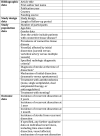Recurrence of cervical artery dissection: protocol for a systematic review
- PMID: 32928855
- PMCID: PMC7488837
- DOI: 10.1136/bmjopen-2020-037124
Recurrence of cervical artery dissection: protocol for a systematic review
Abstract
Introduction: Cervical artery dissection, including carotid and vertebral artery dissection, is an important cause of stroke in the young. Risk of developing cervical artery dissection has been associated with physical activity in various forms and has been presumed to be related to minor trauma and mechanical stretching of the cervical arteries. This systematic review will aim to synthesise data on the risk of recurrent cervical artery dissection after an initial dissection. This information may be applied to further understand the natural history of this disease, and potentially to help direct evidence-based discussions on safe return to activity after dissection.
Methods and analysis: A broad search of multiple electronic databases (Medline, Embase, Cochrane Central Register of Controlled Trials and Web of Science) will be conducted to identify studies published as of 13 November 2019, examining all-comers with cervical artery dissection observed over time. Studies will be screened by two independent reviewers in a two-level process to determine eligibility for inclusion. Data will be pooled from eligible articles and the main outcome of recurrent cervical artery dissection at 5 years will be determined using quantitative analysis.
Ethics and dissemination: Ethics approval is not necessary as no primary data are being collected. The information will be disseminated in the form of a systematic review article which will be submitted to a peer-reviewed medical journal.
Prospero registration number: CRD42020166105.
Keywords: neurology; stroke; stroke medicine.
© Author(s) (or their employer(s)) 2020. Re-use permitted under CC BY-NC. No commercial re-use. See rights and permissions. Published by BMJ.
Conflict of interest statement
Competing interests: None declared.
Figures
References
MeSH terms
LinkOut - more resources
Full Text Sources
Medical


